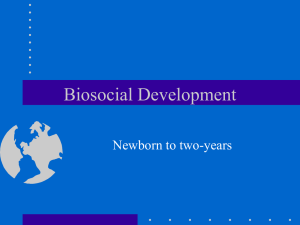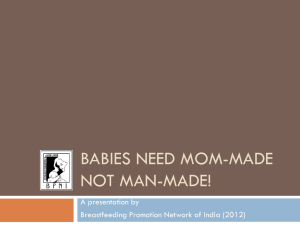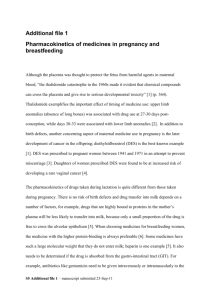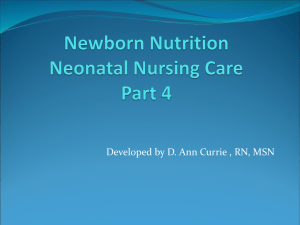Anatomy & Physiology of Breastfeeding
advertisement
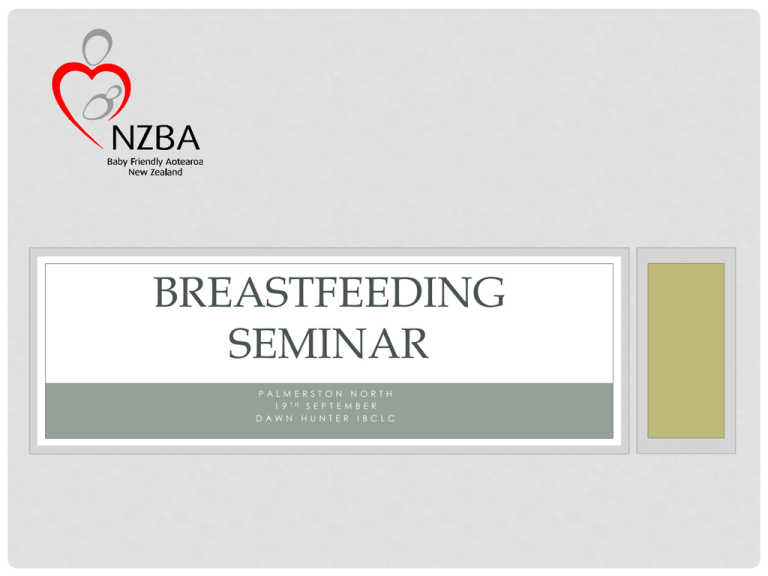
BREASTFEEDING SEMINAR PALMERSTON NORTH 1 9 TH S E P T E M B E R DAWN HUNTER I BCLC THE WORLD HEALTH ORGANIZATION RECOMMENDS: For OPTIMAL health: • Exclusive breastfeeding for six months • Continue breastfeeding up to two years and beyond This is the Gold Standard for infant feeding Colostrum: the first milk. Various colours: white, clear, yellow, pink, brown to name some. Formula Breastmilk An example: the yellowish colour is attributed to beta-carotene a precursor of vitamin A. The presence of this is important for protection against infection and eye development. Amount produced in the first 24 hours 7 – 123mls with the average production as 35mls. Photo: Courtesy Rebecca Behre Idaho The average amount a baby drinks in the first 24hrs = 15+/-11g (Santoro W Jr, Martinez FE, Ricco RG, Jorge SM 2009) Breastmilk is a dynamic fluid: • ‘preterm’ milk, • colostrum, • transitional milk, • mature milk, • weaning milk, • foremilk and • hindmilk Breastmilk Species specific Changes depending on stage of lactation Preterm Colostrum • Transitional • Mature • Weaning • Foremilk and hindmilk Flavours variable – similar to amniotic fluid Contains antibodies Colostrum can be several colours: bright yellow, clear, white, light brown or pink (bloody) as in the case of ‘rusty pipes’ Breastmilk Human milk stimulates the maturation of the GI tract and stimulates the baby’s own immune protection Enzymes, hormones and growth factors are higher in human milk than in other species Many influences on gut maturation and protection e.g. enzymes, lipases, pancreatic amylase Low in casein; higher whey Low protein compared to other species Contains growth hormones, antibodies, leucocytes and other cellular components Matches 50% of infant’s genetic makeup! Fresh and ready to use 100% natural Foremilk & Hindmilk showing different fat content Breastmilk Free 300+ components Soft curds Gastric ½ emptying time = 48mins Breastfeeding = 645kcals/day=117,390kcals/6months =13kgms fat! Nutritionally optimal until around 6 months of age Contains contaminants: Chemicals in human milk may mean that 1: 1,000,000 may have an increased risk of cancer (avoid contact contaminants if possible; for example solvents in paint, dry cleaners, hair dye) Contains stem cells Breastfeeding is a relationship Formula (A Breastmilk Substitute) Derived from a different species or plant base Higher in casein than breastmilk Genetically different from infant Easily contaminated (eg. enterobacter sakazakii) Has expiry date Manmade Inert. Highly processed Fed by bottle – risk of contamination Shelf life affects ingredients Same taste every feed, every day Less than five long chain polyunsaturated fatty acids! Formula <100 components Gastric ½ emptying time = 78 minutes Tough less digestible curds Costs money = ±$2000 per year No cellular component More illness = more absenteeism from work place Controlled by large multi-billion dollar companies Nutritional role only More alkaline pH Alters gut flora Risks Associated with Formula Feeding for the Baby Risks Include: Asthma (Silvers K et al 2012, Gold M, Kemp A. 2005) Atopic diseases (Oddy, W 2004, Matheson MC, Balasuriya A et al 2007) Lower cognitive function (Lucas, A et al 2001, Michaelson KF, Lauritzen L et al 2009) Obesity (Miralles O et al 2006, Weyermann M, Brenner H et al 2007, Huus K, Ludvigsson JF, 2008) Types 1 & 2 Diabetes (Ip S, Chung M, Raman G et al. 2007) Lymphoid malignancies (Bener et al 2008) Rheumatoid Arthritis (Lankarani-Fard et al 2001) Dental caries (Valaitis R, Hesch R, et al 2000) Gastroenteritis (Talayero JMP, Lizán-Garcia M et al 2006) Crohns disease (Klement E et al. 2004) Coeliac disease (Akobeng AK et al. 2006) Necrotising Enterocolitis (Sisk P, Lovelady C et al. 2007) Appendicitis (Pisacane A. et al. 1995) Risks Associated with Formula Feeding for the Baby SIDS (Venneman MM, Bajanowski T et al. 2009) Hypertension (Martin RM, Gunnell D et al. 2005) Heart disease (Martin RM et al. 2005) Leukaemia/childhood cancers (Ortega-Garcia JA, Ferris-Tortajada et al 2007, Bener et al 2008) Otitis media (Hetzner NM, Razza RA et al. 2008) Bacterial meningitis (Silfverdal S, Bodin L, Olcén P 1999) Botulism (Heinig MJ 2001) Ulcerative colitis (Rigas A, Rigas B, Blassman M. et al. 1993) Diarrhoea (Meinzen-Derr JK, Farkas T et al 2004) Urinary tract infections (Marild S, Hansson S et al 2004) Risks Associated with Formula Feeding for the Mother By not breastfeeding the mother has an increased risk of: Bleeding following birth (Chua S et al. 1994) Uterine Cancer (Rosenblatt KA et al. 1995) Ovarian Cancer (Ip S, Chung M, Raman G et al. 2007) Osteoporosis (Ip S, Chung M, Raman G et al. 2007) Breast Cancer (Ip S, Chung M, Raman G et al. 2007) Rheumatoid arthritis (Pikwer M, Bergström U et al. 2008) Risks to infant health …….. we know that artificial feeding is ‘risky for any baby’ (Minchin 1998) A formula fed baby is: five times more likely to go to hospital with diarrhoea twice as likely to go into hospital with a chest infection five times more likely to suffer from a middle ear infection five times as likely to have an infection of their urine twice as likely to develop eczema or a wheeze if they come from an atopic family if premature, twenty times more likely to suffer a rare but serious condition, neonatal necrotising enterocolitis. A hundred lives per year could be saved if all babies were fed their mother’s own milk or donor milk more at risk of sudden infant death syndrome more likely to have reduced cognitive development and decreased visual acuity Kramer & Kakuma Exclusive Breastfeeding “When comparisons are being made with breastmilk, an appeal of ‘no contest’ should be recognised. Natural selection is an optimising process, and the controlled trial for breastmilk, with human survivability as the outcome measure, has been in progress for a minimum of 240,000 years – or 8000 generations” Dr Mike Woolridge (Senior Lecturer in Infant Feeding at the School of Healthcare, Faculty of Medicine & Health, University of Leeds) References 1. ‘Optimal duration of exclusive breastfeeding (Review)’ Kramer MS and Kakuma R. The Cochrane Collaboration. 2009 2. ‘The Optimal Duration of Exclusive Breastfeeding’ Report of an Expert Consultation. Geneva, Switzerland. 28-30 March 2001 3. ‘Weaning as a Natural Process’ Brylin Highton; LEAVEN, Vol 36, No 6. Dec/Jan 2001, p.112-114 4. ‘Influence of breast feeding on subsequent reactivity to a related renal allograft’ Kois WE, Campbell DA Jr, Lorber MI, Sweeton JC, Dafoe DC. J Surg Res 1984 Aug;37(2):89-93 5. ‘The Effect of Breast-milk on Newborn Gut Maturation’ Marie Bosco. Fitgerald Health Education Assoc Inc 6. ‘Supplementation of the Breastfed Baby “Just One Bottle Won’t Hurt” – or Will It?’ Marsha Walker 7. ‘Volume and Frequency of Breastfeedings and Fat Content of Breast Milk Throughout the day’ Kent JC, Mitoulas LR, Cregan MD, Ramsay DT, Doherty DA, Hartmann PE. Pediatrics 2006;117;e387 8. ‘Premature Delivery Influences the Immunological Composition of Colostrum and Transitional and Mature Human Milk’ Castellote C, Casillas R, Ramírez-Santana, Pérez-Cano FJ, Castell M, Moretones MG, LópezSabater, Franch À. American Society for Nutrition 2011. 9. ‘Differential transfer of dietary flavour compounds into human breast milk’ Hausner H, Bredie WL, Mølgaard C, Petersen MA, Møller P. Physiol Behav. 2008 Sep 3;95(1-2):118-24 10. ‘Bacterial Imprinting of the Neonatal Immune System: Lessons From Maternal Cells?’ Perez PF, Dorè J, Leclere M, Levenez F, Benyacoub J, Serrant P, Segura-Roggero I, Schiffrin EJ, Donnet-Hughes A. Pediatrics 2007; 119;e724 11. ‘The genome sequence of Bifidobacterium longum subsp. infantis reveals adaptions for milk utilization within the infant microbiome’ Sela DA, Chapman J, Adeuya A, Kim JH, Chen F, Whitehead TR, Lapidus A, Rokhsar DS et al. PNAS; Dec 2; 2008,Vol 105,No 48: pp.18964-18969 12. ‘Bioactive factors in human milk’ Margit Hamosh (2004) 13. ‘Human Breast Milk as a Source of DNA for Amplification’ Haas DM, Daum M, Skaar T, Philips S, Miracle D, Renbarger. Clinical Pharmacology April 2011 51 (4) References 14. ‘Breast milk: an unappreciated source of stem cells’ McGregor JA, Rogo LJ. Journ of Human Lactation 22(3) 2006 15. ‘The Burden of Suboptimal Breastfeeding in the United States: A Pediatric Cost Analysis’ Bartick M and Reinhold A. Pediatrics 2010;125;e1048. 16. ‘Breastfeeding Protects against Current Asthma up to six years of age’ Silvers KM, Frampton CM, Wickens K et al. The Journal of Pediatrics 30 Jan 2012. 17. ‘Breastfeeding protects against adverse respiratory outcomes at 15 months of age’ Silvers KM, Frampton CM, Wickens K, Epton MJ, Pattemore PK, et al. Maternal and Child Nutrition (2009),5,pp.243-250 18. ‘Breastfeeding and Maternal and Infant Health Outcomes in Developed Countries’ Evidence Report/Technology Assessment No. 153. April 2007. 19. ‘Does prolonged breastfeeding reduce the risk for childhood leukemia and lymphomas?’ Bener A, Hoffmann GF, Afify Z, Rasul J, Tewfik I. Minerva Pediatr. 2008 Apr;60(2):155-61 20. ‘Association between infant feeding patterns and diarrhoeal and respiratory illness: A cohort study in Chittagong, Bangladesh’ Mihrshahi S, Oddy W, Peat JK, Kabir I. International Breastfeeding Journal 2008; 3:28. 21. ‘Breast feeding and acute appendicitis’ Pisacane A, de Luca U, Impagliazzo N, Russo M, De Caprio C, Caracciolo G. 1995 BMJ Volume 310 22. ‘Breastfeeding and Health Outcomes’ David Meyers. Breastfeeding Medicine Vol 4 2009 23. ‘Evidence on the long-term effects of breastfeeding: Systematic Reviews and Meta-analysis’ WHO 2007 24. ‘Early menopause is an independent predictor of rheumatoid arthritis’ Mitra Pikwer, Ulf Bergström, JanÅke Nilsson, Lennart Jacobsson, Carl Turesson. Ann Rheum Dis Oct 2011. 25. ‘A formula fed baby is ….’ Kramer & Kakuma (2002) Midwifery Digest 14:2 (2004) 26. ‘Did you ever wonder what’s in ……?’ Cecily Heslett, Sherri Hedberg and Haley Rumble 2007
